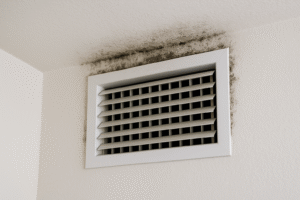If you live in North Texas, you already know the weather can be unpredictable, hot summers, sudden thunderstorms, and sticky humidity that seems to linger for weeks. While this climate shapes our lifestyle, it also creates the perfect environment for indoor mold growth.
High humidity isn’t just uncomfortable; it can quietly damage your home and impact your health. In this post, NTX Enviro explains how humidity in North Texas affects mold growth indoors, what signs to look for, and how you can protect your property.
Why Humidity Matters for Mold
Mold thrives in warm, damp environments. According to the IICRC S520 Standard for Professional Mold Remediation, mold can begin to grow when indoor humidity stays above 60% for extended periods.
- Moisture = Mold Fuel: Mold spores need water to grow, and humidity provides it directly from the air.
- Porous Materials Are Vulnerable: Drywall, carpet, wood, and insulation absorb airborne moisture, making them prime spots for hidden mold.
- Condensation Issues: When humid indoor air meets cool surfaces (like windows or A/C vents), condensation forms, another mold growth trigger.
In North Texas, summer humidity often exceeds 70%, which means homes are frequently at risk if moisture isn’t controlled.
Seasonal Humidity Challenges in North Texas
Summer Heat + Humidity
- Long stretches of 90–100°F days trap heat and moisture indoors.
- Air conditioning helps with cooling but often struggles to remove enough humidity.
- Poorly sized or aging HVAC systems make the problem worse.
Spring & Fall Storms
- Sudden downpours and flooding raise humidity levels quickly.
- Even without visible leaks, moisture can seep into walls and foundations.
- Homes without proper vapor barriers or drainage see lingering dampness.
Winter Heating Cycles
- While winter air is generally drier, indoor humidity can still spike in homes that are tightly sealed for energy efficiency.
- Bathrooms, kitchens, and laundry rooms remain high-moisture zones year-round.
Signs That Humidity Is Fueling Mold Growth Indoors
Even if you don’t see visible mold, high humidity leaves behind warning signs. Look out for:
- Musty Odors in closets or HVAC systems
- Condensation on Windows or A/C vents
- Warped or Buckled Wood Flooring
- Peeling Paint or Bubbling Drywall
- Recurring Allergy Symptoms like coughing, sneezing, or watery eyes indoors
If you notice these signs, it may be time to schedule a professional mold inspection.
Health Risks of Mold in Humid Climates
Mold exposure can impact health, especially for sensitive individuals. According to the CDC and EPA, mold may cause:
- Worsening asthma or allergies
- Sinus irritation and headaches
- Persistent cough or respiratory issues
- Fatigue and difficulty concentrating
In a region like North Texas, where humidity and storms frequently trigger indoor mold growth, these risks are higher without proactive monitoring and prevention.
How to Control Humidity and Prevent Mold
- Monitor Indoor Humidity
- Use a hygrometer (inexpensive at hardware stores) to keep humidity between 30–50%.
- Check high-risk areas like bathrooms, kitchens, and attics regularly.
- Maintain HVAC Systems
- Schedule seasonal A/C maintenance to ensure proper dehumidification.
- Replace filters regularly during heavy use.
- Ask your HVAC technician about adding a whole-home dehumidifier.
- Improve Ventilation
- Run exhaust fans during and after cooking, showering, or doing laundry.
- Ensure attic vents are clear and functional.
- Open windows on low-humidity days for natural ventilation.
- Address Water Intrusion Quickly
- Fix leaks within 24 hours to prevent hidden mold colonies.
- After storms, inspect attics, basements, and crawlspaces for moisture.
- Dry wet carpet, drywall, or upholstery immediately with fans and dehumidifiers.
- Schedule a Mold Inspection After Storms or Flooding
If your property has experienced water damage, leaks, or prolonged high humidity, a licensed mold consultant can perform:
- Moisture mapping
- Air quality testing
- Surface sampling
- Documentation for insurance and real estate transactions
Why Mold Inspections Are Essential in North Texas
The Texas Mold Law (Occupations Code, Chapter 1958) requires certain mold assessment and remediation practices to be performed by licensed professionals.
At NTX Enviro, we provide:
- Unbiased Mold Inspections: no conflict of interest since we don’t perform remediation.
- Detailed Testing Reports: including lab analysis of air and surface samples.
- Clear Guidance: helping homeowners understand whether remediation is necessary and what steps to take.
This not only ensures compliance but also protects your investment, especially when selling or buying property.
Conclusion
Humidity in North Texas isn’t going away, but you can take steps to protect your home and family. By understanding how humidity affects mold growth indoors, you’ll be better prepared to spot early warning signs, maintain healthy air quality, and avoid costly repairs.
Don’t let North Texas humidity turn into a mold problem.
👉 Schedule a Professional Mold Inspection with NTX Enviro Today
Protect your property, your health, and your peace of mind.

